THE 1001 REWARDS & RECOGNITION FIELDBOOK
BOB NELSON  DEAN SPITZER
DEAN SPITZER
Workman Publishing, New York
Copyright 2003 by Bob Nelson
All rights reserved. No portion of this book may be reproducedmechanically, electronically, or by any other means, including photocopyingwithout written permission of the publisher. Published simultaneously in Canada by Thomas Allen & Son Limited.
Library of Congress Cataloging-in-Publication Data
Nelson, Bob, 1956
The 1001 rewards & recognition fieldbook : the complete guide / by Bob Nelson and
Dean Spitzer.
p. cm.
eISBN-13: 9780761153573
1. Incentives in industry. 2. Employee motivation. I. Title: One thousand and one
rewards and recognition fieldbook. II. Spitzer, Dean R. III. Title.
HF5549.5.I5 N457 2002
658.3142dc21
2002029605
Interior design by Sophia Stavropoulos
Cover and interior illustrations by Burton Morris
All company logos used in Bob & Deans Recognition Honor Roll are property of the companies referenced and used with their permission.
CEO Santa and A Modern-Day Guardian Angel are used with permission of Corporate Meetings & Incentives magazine.
Workman books are available at special discount when purchased in bulk for special premiums and sales promotions as well as for fund-raising or educational use. Special editions or book excerpts also can be created to specification. For details, contact the Special Sales Director at the address below.
Workman Publishing Company, Inc.
225 Varick Street
New York, NY 10014-4381
In memory of Sally Kovalchick,
19382000
Editor,
1001 Ways to Reward Employees
Contents
PART I
RECOGNITION FUNDAMENTALS
PART II
GETTING STARTED WITH RECOGNITION
PART III
ORGANIZATIONAL RECOGNITION
PART IV
ISSUES AND CHALLENGES IN RECOGNITION
PART V
RECOGNITION TOOLS
PART VI
RECOGNITION RESOURCES
PART VII
SELECTED ARTICLES
Acknowledgments
Appreciation is a wonderful thing: it makes what is excellent in others belong to us as well.
Voltaire, writer
The authors would like to acknowledge the contributions of the following people, without whom this book would not have been possible:
Dr. Aubrey Daniels, pioneer in the science of positive reinforcement; Dr. Ken Blanchard, mentor and role model; and Dr. Peter F. Drucker, father of modern management, for their wisdom and inspiration, and their contributions to the disciplines of motivation and management.
Drs. Don Griesinger, Harvey Wichman, and David Drew of the Peter F. Drucker School of Management at Claremont Graduate University, who served on Bobs Ph.D. advisory committee for his doctoral dissertation on the use of nonmonetary recognition; Dr. Joseph Maciariello and Dr. Don Griesinger for helping to inspire and encourage Bob to pursue his interest in employee recognition and motivation.
Peter Economy, longtime friend, confidant, and business writer extraordinaire, for suggesting that the authors collaborate on a book about recognition and rewards, and for his extensive help in researching, interviewing, and drafting many of the cases found in the manuscript, and for reviewing and editing the manuscript.
The fine staff at Workman Publishing Co., including Peter Workman, Bruce Harris, Susan Bolotin, Jenny Mandel, Kim Cox, our editor Richard Rosen, and the rest of the team that helped bring this resource to fruition: Paul Gamarello, Lisa Hollander, Sophia Stravropoulos, Anne Cherry, Kelli Bagley, Megan Nicolay, and Katherine Adzima, among many others.
Rebecca Taff, managing editor of Bob Nelsons Rewarding Employees newsletter, who helped to compile much of the margin-alia used in this book; and Daryl Magdziack, administrative coordinator for Nelson Motivation Inc., for his assistance in typing and compilation of various portions of the manuscript.
Bob would also like to thank his spouse, Jennifer, and children, Daniel and Michelle, for their ongoing patience, love, and support.
Dean would like to thank his wife, Cynthia, and son, David, who give him all the rewards and recognition he will ever need.

Foreword
When Bob Nelson and Dean Spitzer approached me about writing the foreword to their new book, The 1001 Rewards & Recognition Fieldbook, I was honored. Ive known them both for many years and appreciate their work. Bobs 1001 Ways to Reward Employees, now in its thirty-ninth printing, with close to 1.5 million copies in print, indicates that the topic has tremendous appeal to business audiences and that he has written about it in a way that has practical value. I am sure that all who read it get ideas about how to use recognition more effectively.
I know of Bobs passion for the topic of recognition and for helping others see its potential. He is known for generating a host of new ideas that can be applied immediately. He provides an easy method for the busiest managers to work recognition into their daily behavior. Although Bob has spread the word about the power of recognition through his many lectures and seminars, he finds time to be a student and researcher. He recently completed a three-year doctoral study on the subject, and shares his findings in this fieldbook. His efforts to anchor what he writes about in scientifically derived principles of human learning marks a key difference between this book and many others written on this topic.
Bob and Dean have created a substantive treatment of reward and recognition in the workplace. The 1001 Rewards & Recognition Fieldbook goes well beyond anecdotes, suggestions, and quotes to show readers why and how recognition works to achieve desired results. In this comprehensive resource, they present evidencefrom research, surveys, and actual practicethat recognition and nonmonetary rewards, properly applied, are great motivators.
Bob and Dean show you how you can act spontaneously in implementing recognition and reward programs, while keeping a long-term strategic focus and moving toward creating a true recognition culture where you work. The 1001 Rewards & Recognition Fieldbook walks you through a detailed organizational recognition plan to sustain long-term initiative at multiple levels across the organization. Their plan allows managers the freshness and flexibility to build a culture of positive reinforcement that gets people excited! And their plan allows the employee to be active in defining and applying recognition and reward for others as well as themselves. This kind of approach creates the right conditions for personal accountability and commitment at all levels.
Bob and Dean make the case that recognition matters, perhaps more now than ever before, in our relationships and in our organizations. They show that recognition is doable, regardless of your constraints or limited resources, and that recognition is for everybody, and everybody needs to play a part in making it happen.
The authors have poured their extensive experience into this book, and from each page you will learn a little more about what I consider to be the greatest management principle in the world. Thank you, Bob and Dean.
Dr. Aubrey Daniels
Chairman, Aubrey Daniels International; author, Bringing Out the Best in People, Other Peoples Habits,


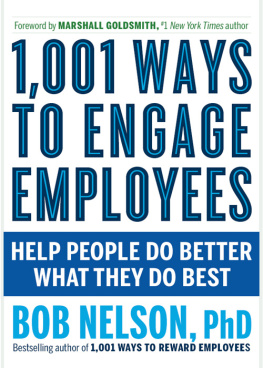
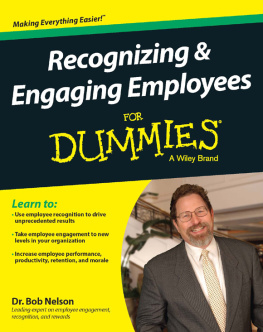
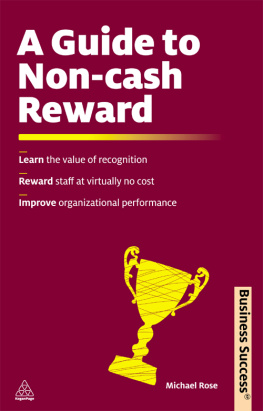
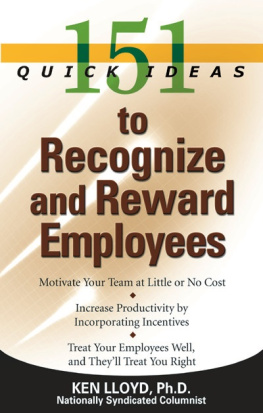
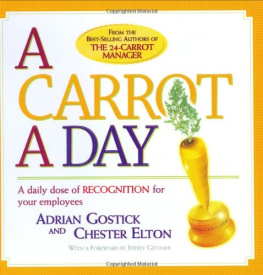
 DEAN SPITZER
DEAN SPITZER